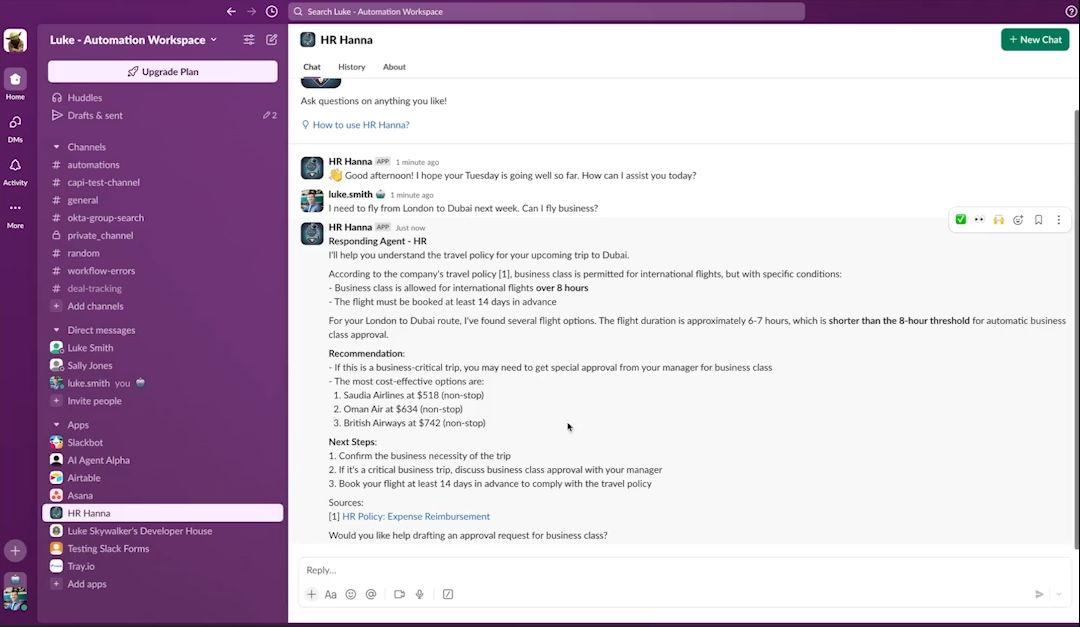Everything you need to know about AI agents for HR


Adam White
Content Marketing Associate @ Tray.ai
Learn how AI agents for HR automate onboarding, enforce policies, and resolve employee requests so HR and IT teams can deliver faster, more secure service at scale.
Why HR is primed for AI agents
HR teams handle some of the highest volumes of employee inquiries in the enterprise. A typical HR shared-services organization (SSO) supports ~149 employees per HR full-time employee, with Tier-1 agents handling ~21 inquiries per day each, meaning the majority of their work is high-volume, repetitive, and time-sensitive . From PTO requests to policy lookups, onboarding, and compliance checks, many of these processes are rules-based and relatively predictable.
At the same time, HR data is among the most sensitive information a company holds, requiring strict governance and access control. The combination of high-volume repetitive work paired with strict compliance requirements makes HR an ideal starting point for AI agents. These agents do more than surface knowledge. They can reason over data, enforce policy, and take action across systems to resolve requests.
What are AI agents in HR?
AI agents differ from chatbots or scripted workflow tools. Where chatbots offer canned responses and RPA scripts automate narrow tasks, agents combine three essential elements:
Knowledge ingestion: grounding themselves in HR policies, documents, and employee records.
Tools: acting on requests, such as booking PTO or escalating exceptions.
Guardrails: enforcing compliance and ensuring employees only access authorized information.
In practice, an HR agent can retrieve information from a knowledge base, apply company policies, and then act by creating a ticket or booking time off, all while logging its steps for governance and auditability.
Why HR is a high-impact starting point
Employees ask thousands of questions every year, and every unanswered one slows the business down. Finding the right policy, getting approval, and taking action can take hours of employee and HR time that could be spent on higher-value work.
This volume isn’t going away. It’s growing as workplaces become more complex. Solving it at scale requires more than portals and ticket queues. It calls for AI agents that can reason and act. By 2029, AI agents will autonomously resolve 80% of common service issues, reducing support costs by up to 30%.

Self-service adoption is already widespread, with 94% of organizations offering an HR portal. But outcomes lag: only ~9% of employees fully resolve issues in self-service today, even though leaders estimate that ~40% of live volume could be automated or deflected with better design and tools.
For IT and HR leaders, the business case is clear. Each manually processed request drives up operational cost, consumes staff capacity, and delays response times. AI agents address all three challenges by deflecting routine questions into self-service, applying policies consistently, and protecting sensitive data with built-in governance.
Core use cases for AI agents in HR
Employee self-service
Employees no longer need to submit tickets for routine questions. An HR agent can retrieve relevant policies, check entitlements, and act on requests directly.
In one example, an HR agent evaluated whether an employee could book business class for an international flight by checking company travel policy, comparing flight duration to policy thresholds, and providing cost context, all inside Slack.

Onboarding and offboarding
AI agents can orchestrate processes that span multiple systems. For onboarding, they can trigger provisioning, paperwork, and training notifications. For offboarding, they can ensure access is revoked, assets are collected, and compliance steps are completed.
Given that onboarding/offboarding are among the most cross-functional, error-prone processes, automating them can significantly reduce compliance risk and improve employee experience.
See how a leading social network uses HR agents to resolve employee requests faster.
Policy enforcement and compliance
An HR agent can apply company policies in real time. For example, when an employee attempted to book PTO one day in advance, an HR agent enforced the seven-day policy and instead created a review ticket for HR staff. The same agent later approved a compliant PTO request, submitted it into the HR system, and updated the employee’s remaining entitlement.
This kind of automation is becoming critical: BambooHR data shows PTO requests have risen ~11% per year since 2019, with more than one-third of employees requesting time off monthly.
HR-IT collaboration
HR and IT are deeply interconnected, and nowhere is this more obvious than in employee lifecycle events like onboarding, role changes, and offboarding. Nearly every HR process depends on IT systems for provisioning, permissions, and access control.
AI agents make this collaboration even more critical. To be effective, an HR agent needs to:
Read and write to multiple systems (HRIS, payroll, ITSM, identity management)
Follow security and compliance requirements when handling sensitive employee data
Trigger cross-functional workflows such as creating a new hire record in Workday, provisioning accounts in Okta, and sending equipment requests to IT support
HR and IT must collaborate closely to make AI agents work at scale. Where HR focuses on policy accuracy and employee experience, IT teams must consider governance, integration architecture, and security posture. Without IT’s involvement, agents risk becoming brittle, shadow-IT automations. With IT involved, agents can be deployed with centralized logging, RBAC, and observability, giving leaders confidence that automations are secure, auditable, and scalable.

When done right, HR and IT collaboration turns employee requests into end-to-end workflows. Employees get faster resolution, HR reduces manual workload, and IT ensures policies and access controls are enforced consistently.
Want to learn more about connecting HR systems? Explore our deep dive on the ADP Workforce Now API.
Challenges of deploying HR AI agents at scale
Despite strong potential, many enterprises still struggle to take HR agents from pilot to production. Integration remains a top barrier: connecting agents to HRIS, payroll, and ITSM platforms is complex and requires a unified integration layer.
Data sensitivity is another major concern. HR data requires strict guardrails to prevent unauthorized access and ensure compliance. Without these controls, agents cannot be trusted to operate at scale.
Finally, scalability is a recurring challenge. According to our enterprise AI agent survey, 86% of organizations say they need upgrades to their current tech stack to move from prototype to production. Analysts echo this: by 2029, 80% of enterprises with mature automation practices will pivot to a consolidated platform that orchestrates both business processes and agentic automation.

Best practices for HR AI agents and IT collaboration
To succeed with AI agents in HR, IT and HR teams should start with well-defined, high-volume processes such as PTO requests and policy lookups. These provide immediate impact while minimizing risk.
Governance should be applied from the beginning. Role-based access, audit logging, and guardrails are not optional when handling sensitive HR data. Observability also matters. IT teams should be able to see how agents reason, what data they use, and how they arrive at decisions.
Finally, deployment should be cross-functional. HR teams bring policy expertise, while IT ensures systems integration and security. Together, they can design agents that are both accurate and secure.
The future of AI agents in HR
AI adoption in HR is moving quickly, but the real opportunity lies in cross-functional orchestration. Today, HR agents can automate service requests and enforce policies. Tomorrow, they will work alongside IT, finance, and support agents to deliver a unified employee self-service experience.
With 85% of HR organizations already using some form of conversational solution (e.g., chatbots or virtual agents), the stage is set for next-generation AI agents that can resolve issues end-to-end rather than just provide scripted answers .
With Tray Merlin Agent Builder, IT and HR teams can easily build and deploy an HR agent. See one we built in action:
AI agents in HR address the highest-volume, most repetitive processes in the enterprise, while enforcing policies and protecting sensitive data. With HR teams supporting hundreds of employees per FTE and inquiry volumes rising year over year, AI agents offer a force multiplier that delivers faster, cheaper, and more consistent service.
For IT and HR leaders, the message is clear: start with repeatable, policy-driven processes, apply strong governance, and use composable building blocks to create agents that can evolve over time. The result is faster HR service and a scalable foundation for employee self-service across the enterprise.